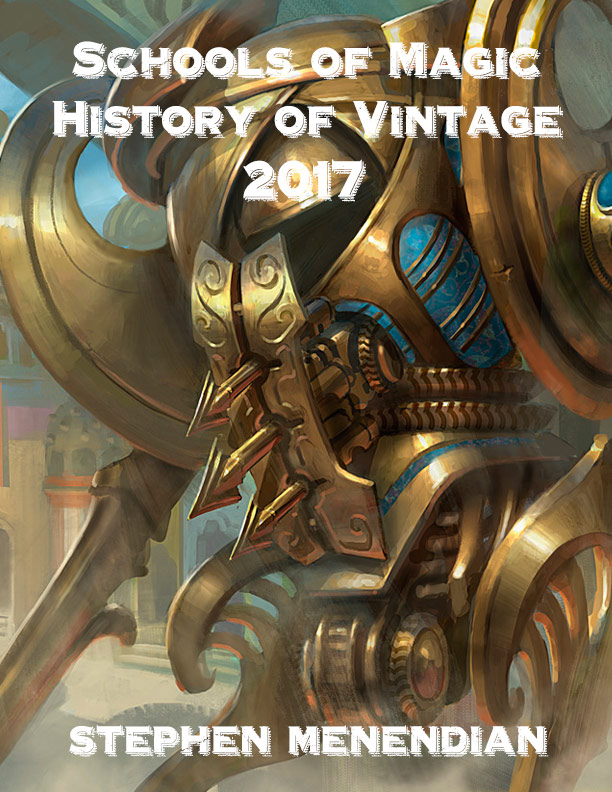Description
Years in the making, read the conclusion to Stephen Menendian’s epic History of Vintage. 2017 was an incredible year of Vintage experiences, long anticipated restrictions, and surprising unrestrictions. Stephen’s book closes with a special review of the great Schools of Vintage Magic, and reflections on 25 years of an incredible game.
[Begin Free Excerpt From Schools of Magic: History of Vintage – 2017]
Aether Revolt Arrives
The conclusion to Kaladesh block, and the 73rd Magic expansion set, Aether Revolt was yet another artifact-focused set featuring new vehicles, two new mechanics, and an eclectic assortment of spells. Although there appeared to be a few role players and enablers that might see Vintage play, Vintage interest in this set was overwhelmingly focused on a single card, Walking Ballista.
A swift consensus emerged that Ballista was a general upgrade to Triskelion in Workshop Aggro decks, with even broader applications. Triskelion has been a Workshop staple since the days of the early Stacker and TNT variants, but was given a boost with the printing of Arcbound Ravager. Together, they could be used to abbreviate a game state with a quicker kill that did not require an attack step, using Arcbound Ravager’s modular ability to suck up power and then dump counters on to Triskelion for a lethal dose of direct damage.
Ballista may not have the natural power that Triskelion does for 6 mana, but the greater flexibility and ease of casting as well as the ability to add counters with excess mana seemed more advantageous than not. Ballista could be played in the late game, when mana is abundant, for a massive amount, or simply refueled in the same way. While naturally playable in Workshop decks, the low end flexibility suggested that Ballista might see play in other strategies as well, such as Eldrazi decks, which featured Ancient Tomb to scale Ballista up.
Under other circumstances, this printing would have been merely propitious given natural synergies with cards like Arcbound Ravager and ways in which it can be weaponized against planeswalkers. But arriving at the zenith of token-generating strategies, Ballista represented a direct assault on one of the prevailing strategies of the day, just as Painter’s Servant had arrived in 2008 amidst a Tyrant Oath and Flash metagame. Ballista would make quick work of Young Pyromancer or Delver of Secrets, but even a modest Ballista could knock out a Mentor, and then mop up remaining Monk tokens. In the short run, this development relieved some pressure from agitation to restrict something from the Gush Mentor deck. As I wrote at the time, “Aether Revolt’s arrival may have forestalled or merely postponed a hard reckoning, by giving Workshops a nearly perfect implement against Gush strategies, strengthening both O’Brien School strategies as well as Paradoxical Outcome strategies’ position in the metagame.”
Ballista presented something of a double-edged sword. While it might attack the format’s dominant blue-based strategy, it could just as easily tilt the format back towards Workshop dominance. For several years, the format ping-ponged between restrictions in Xerox and Workshop decks. Ballista could either open the metagame up more broadly, or swing the format back towards Workshop dominance or some uneasy duopoly of Shops and Mentor.
Initial fears seemed realized when, at the end of January, the MTGO Power Nine Challenge was won by Rich Shay with a Ballista Workshop deck, defeating another Ballista Workshop mirror in the finals.
[End Free Excerpt]

